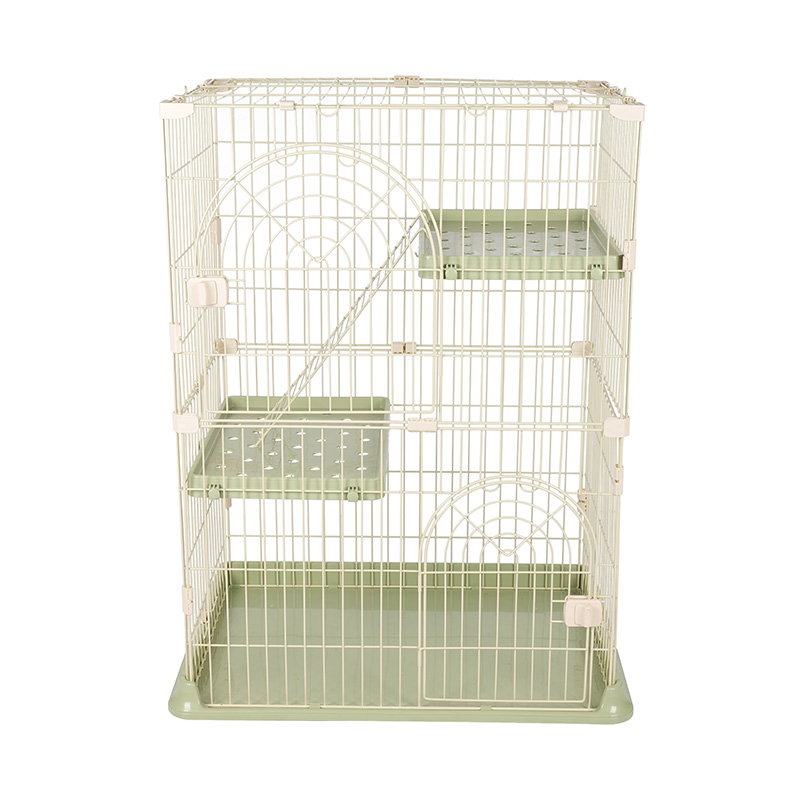Small pet animal cages As pet supplies for long-term use, their service life and safety are of vital importance. Since pets move frequently in cages, they often bite, scratch, defecate, etc., so the surface of metal or plastic materials is prone to wear, corrosion, paint loss, etc., which not only affects the appearance, but also may bring health risks.
In order to extend the service life of small pet cages, improve durability and safety, a variety of surface treatment technologies can be used to enhance the corrosion resistance, wear resistance and environmental protection performance of the materials. The following are several common and effective surface treatment methods and their working principles:
1. Electroplating
Electroplating is a technology that deposits a metal layer through electrolysis to cover the surface of the substrate. It is often used to improve the rust resistance and appearance texture of metal materials.
Zinc Plating: A layer of zinc is plated on the iron or steel structure to form a protective layer that isolates air and moisture, effectively preventing oxidation and rust.
Nickel plating/chrome plating: First, nickel plating is used as the base layer, and then the chrome plating is used as the surface layer to make the cage surface smoother and harder, with good wear resistance and oxidation resistance, while improving the appearance of the product.
This type of treatment is particularly suitable for cage structures that require high-strength support, but it should be noted that heavy metal pollution may be involved in the electroplating process, and a process that meets environmental protection standards should be selected.
2. Powder spraying
This is a technology that electrostatically sprays dry powder paint onto the metal surface and then cures it at high temperature to form a coating.
The powder coating is dense and uniform, has strong adhesion, and is not easy to fall off;
The surface is smooth and the colors are diverse, which is suitable for creating beautiful and practical pet cages;
It has strong UV resistance and is not easy to fade;
It has good adaptability to humid environments and is suitable for bathrooms, balconies and other places.
When using this technology, ensure that the selected powder is food grade or non-toxic material to prevent pets from accidentally ingesting harmful substances.

3. Hot-dip galvanizing
Hot-dip galvanizing is to completely immerse the steel in molten zinc liquid to form a thicker zinc alloy protective layer on its surface.
It has excellent anti-corrosion performance, especially suitable for use outdoors or in high humidity environments;
The coating thickness is much higher than ordinary electroplating, which can provide longer protection;
The service life can reach decades.
Although the cost is high and the processing process is complicated, it is a surface treatment method that is worth investing in for large or outdoor pet cages that need to be used for a long time.
4. Anodizing treatment
Mainly used for aluminum alloy materials, it generates an aluminum oxide film on the surface through electrolysis to enhance its hardness and corrosion resistance.
Improve the wear resistance and oxidation resistance of the aluminum alloy surface;
Can be dyed to increase the diversity of product design;
Suitable for lightweight indoor pet cages, especially products that focus on appearance and environmental performance.
It should be noted that this treatment method is only applicable to aluminum alloys, not iron or steel structures.
5. PVC plastic coating treatment
Wrap a layer of PVC material outside the metal mesh or frame to form a soft and durable protective layer.
Increase touch comfort and reduce the risk of scratches;
Waterproof, rust-proof, easy to clean;
Absorb some noise, suitable for multi-pet families or apartments.
However, PVC materials may age under long-term sunlight or high temperature, so it is recommended to choose high-quality PVC materials with anti-ultraviolet ingredients added.
6. Functional coatings
With the development of technology, some new functional coatings have also begun to be used in the manufacture of pet cages:
Antibacterial coating: Add silver ions or other antibacterial ingredients to inhibit bacterial growth, suitable for environments with high hygiene requirements.
Anti-scratch coating: Improve surface hardness and reduce wear caused by pet scratching.
Self-repairing coating: Tiny scratches can automatically recover at a certain temperature, extending the appearance of neatness.
Although these coatings are high-end applications, they can significantly enhance the added value and user experience of the product.
In addition, during the production process, it is necessary to strengthen the testing of coating adhesion, uniformity, and non-toxicity to ensure that the product meets food safety standards and animal welfare requirements.


 English
English Español
Español



